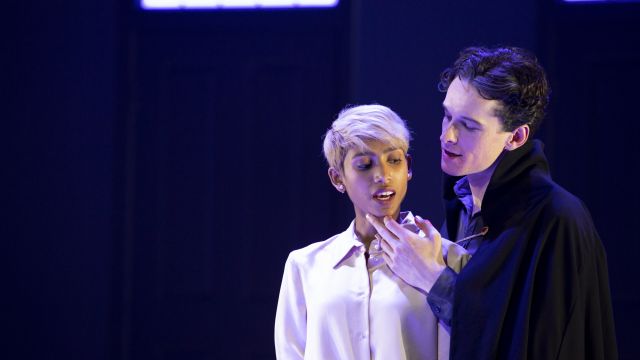Nosferatu
This is a clever adaptation of the original silent German Expressionist film which was itself an adaptation of Bram Stoker’s 1897 novel Dracula. This heritage is clearly acknowledged in the play by paying homage to some of the staple elements such as the homoerotic undertones and the use of the motifs of blood and sucking to express both eroticism and violence.

The set also captures some of the expressionist qualities of the original film by creating a very sleek and linear set with sharp angles and contrasting shades of black and white. This also operates to highlight the colour red and creates a very strong cohesive aesthetic in the stage design. The staging also incorporates some excellent special effects which is especially stunning when we see the demise of Nosferatu. These effects work extremely well to convey the horrific and eerie nature of the story. The setting of the play in a remote mining town in Tasmania also works well to capture the sinister aspects of the story.

The performances are less refined in terms of their focus. Orlok (Jacob Collins-Levy) is portrayed with irony and humour, and this works well given the enormous heritage of the queer aspects of the character. This does not always marry well with the other characters who are frequently conveyed with more intensity and seriousness. At times this can create a clash in the register and tone of the performances. Tom (Keegan Joyce) is especially well portrayed as naïve but more innocent than gullible. Kate (Sophie Ross), who is the most grounded character and important in the overall resolution of the play, is consistent in maintaining the gravity of the story. Knock (Max Brown) is portrayed as quite weak and flawed and Brown provides some excellent examples of a gradual but deep descent into madness. Ellen (Shamita Siva) is portrayed as extremely alluring but the very mixed nature of her emotions is played down and could be made more perceptible. Interestingly, in this play, Orlok is positioned as villainous because of his capitalist and aristocratic tendencies. These elements could also be explored more in order to bring more consistency across the styles of performance.

Nonetheless, this is a fascinating and worthwhile experiment in exploring the Dracula myth. The way this story speaks to the recent health concerns that have plagued humanity, and the social, political, and environmental issues that they highlight, is one of the strengths of the play.
Patricia Di Risio
BUY THE SCRIPT AT BOOK NOOK - AUSTRALIA'S PERFORMING ARTS BOOKSHOP
Photographer: Pia Johnson
Subscribe to our E-Newsletter, buy our latest print edition or find a Performing Arts book at Book Nook.

